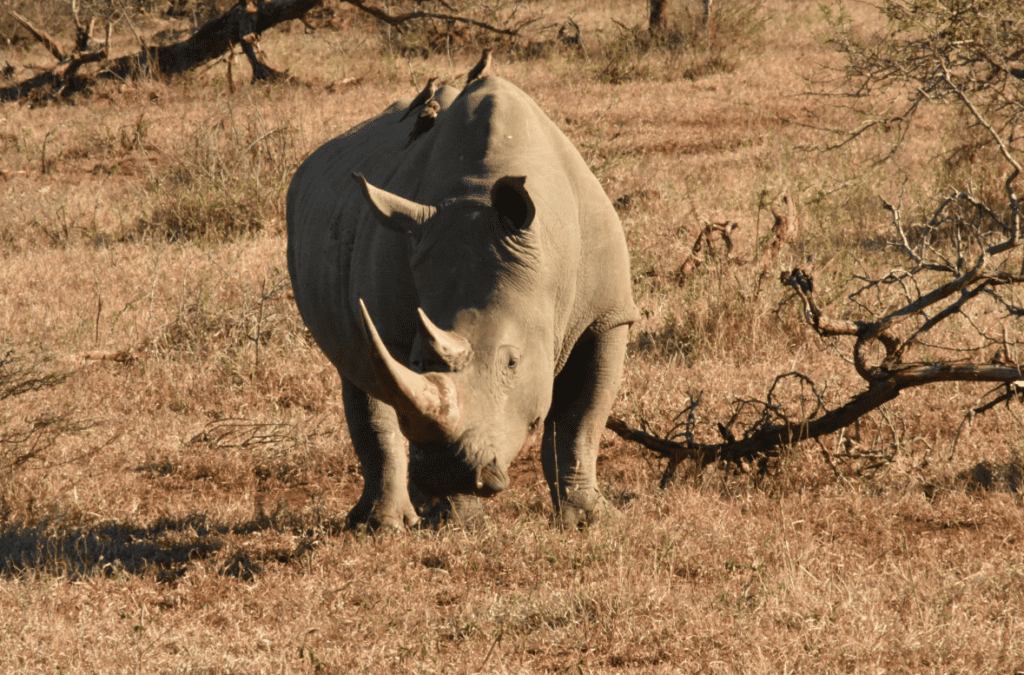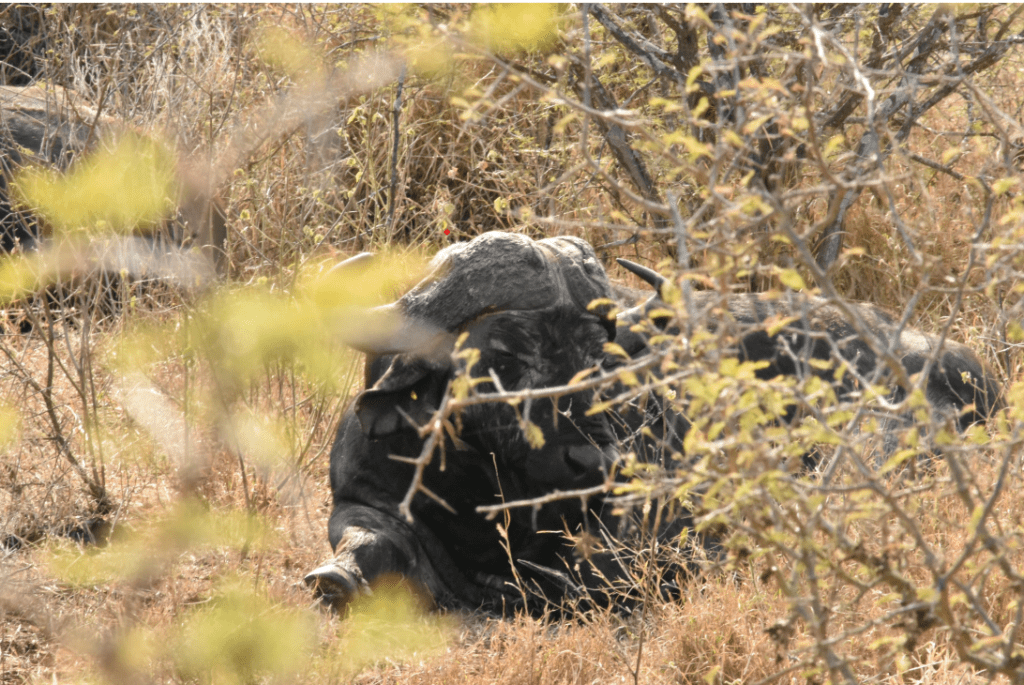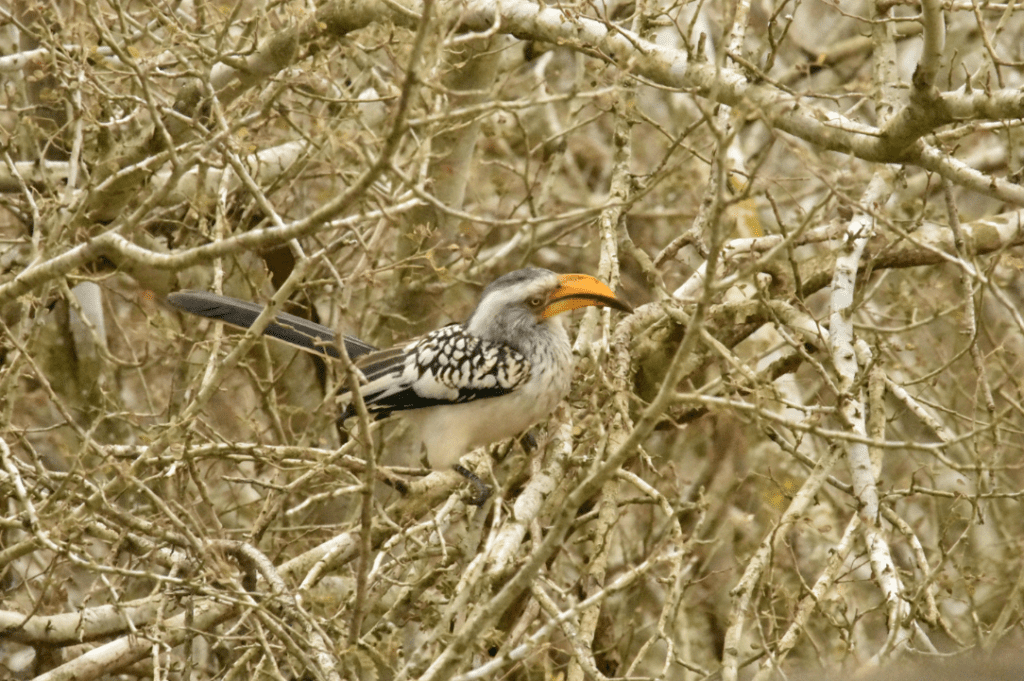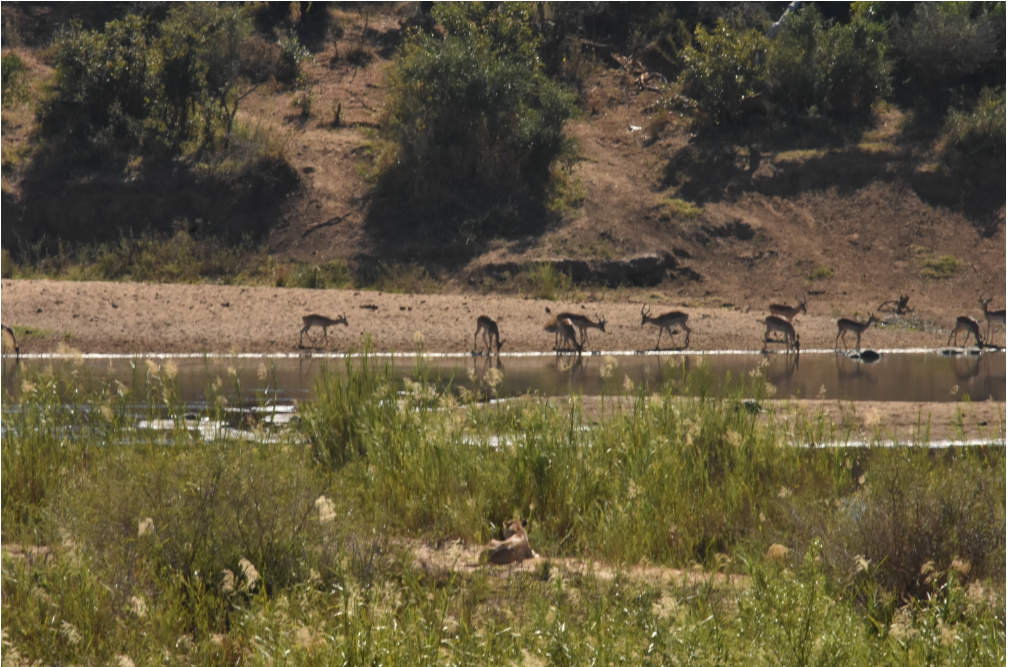Kruger part 2: “Just to let you know, there’s a rhino over there”
The walking cancer cure

Four down, one to go. But Jan has had his eye on the clock, and we can’t stay here forever. He decides to end our day stopping in an open area of bush where he talks about the park’s history. I’ve always been that kid in the class that looks out the window way too much, and I now have windows on all sides. I scan the tops of the bushes, see the boulder-like grey figure of a rhino and politely interrupt the lesson.
Now, I can’t describe too many details since visitors are being asked to keep quiet about sighting locations to avoid poachers getting useful information – Kruger’s rhino poaching can only be described as a war, with rangers being armed to the teeth, sniffer dogs being used to detect bushmeat and horns, and skirmishes between poachers and rangers occurring all too often. Just the week before I arrived, a ranger had been killed. Many parks are now resorting to cutting off rhino horns whilst keeping the owners alive, to make them that much less valuable, as horns fetch up to $300,000, driven by beliefs in China and Vietnam that medicine from rhino horn can cure illnesses – even though, scientifically, it’s been proven that you’re better off eating your own fingernails. The chop makes me a little divided on how to feel about the individual with a prehistoric horn standing right beside our vehicle. On the one hand, it just wouldn’t be the same seeing a stump and I very much hope other visitors get to experience a sight like this, but on the other hand such beauty increases the odds of finding a fly-covered corpse.
Unfortunately, the next day, that’s exactly what we find, not far from Lower Sabie. The guide assures us that it was probably not poachers, but more likely old age, as the horn is still attached plus they would never hunt this close to a camp. But a guy at my camp is not so sure; a couple of days ago, he saw a rhino injured by what was unmistakably a gunshot wound (with photographic evidence). Later that evening, it turns out they were the same individual; the rhino finally succumbed to its injuries.
Kruger has the right mentality for dealing with rhino poaching, and I even feel South Africa takes this more seriously than its nationwide crime problem – poaching is treated with a sense of “enough is enough”, while the latter is “just the way things are”. The problem is that neighbouring Mozambique doesn’t have nearly the same amount of motivation or resources, and the poachers merely have to cross the border before they get away scot-free. At some point, this war will no doubt involve throwing the book at Mozambique. I have faith that Kruger will emerge victorious, but there is definitely much to be done yet.
Round 2

All the big 5 in one day is a rarity, according to Jan, and the dorm couple are ecstatic, but I’ve still to find cheetah. Now, I have no illusions that these will be easy to find, as I was warned that they are the rarest of the big cats and Kruger is not the best place for them. I keep telling myself that, next time in Africa, I will be going to better cheetah habitat, but I can never fully ostracise that inner hope. Besides, I’ve got a few days left in Marloth Park, in case I need the extra time. So, I get myself on another drive.
For some reason it’s much warmer today, though maybe it’s because I cocooned myself from the get-go. I’m joined by a girl from my dorm, another sedan convert. Something tells me it’s going to be a good day. Maybe it’s the bull elephant we find not far from the entrance, its tusks gleaming at us. They, along with that muscly trunk, dislodge a tree as if it were changing a lightbulb. Elephants sometimes need to be culled for this very reason, but the park makes sure nothing goes to waste. The meat is used to supply villages, and can last them for months.

We drive through a much drier part of the park, stopping for the same animals as yesterday, but also new things too. The new guide, Sophia, is a bit different to Jan in that she’s more willing to point out birdlife and talk about it, like the “flying bananas” (hornbills), magpie shrikes and parrots that advertise their presence in the trees. A family of warthogs stumbles around a rocky waterhole, wondering why taking a bath has to be so complicated, and a herd of impala surveys the bushes, looking nervous. It’s a bit anti-climactic when it turns out to just be rival bulls, but then one appears with a horn pointing downwards, the result of a particularly intemperate duel. Unfortunately, its horn will never be repaired or regrow – subsequently, it can never mate again. Mother Nature can be cruel.

The Magnificent Seven
We reach the paved road, and a promising sight greets us; a group of cars huddled together. Sophia shares some exciting information, that cheetah have been sighted in this area. “This could be it”, I think to myself. We slide into a spot, and Sophia talks to the driver of the jeep in front. There’s a family of them, five individuals. They’re apparently just lying on the road. Right behind a bush. I urge Sophia to drive forward into the extra few inches of space in front of us, and it’s just enough. Voila.

Slender and spotty, more dog in appearance than cat. It is here that another benefit of not self-driving becomes apparent, for we get a good enough view above the roofs of the sedans who jostle for a peek at the family. It doesn’t look like they’re going anywhere in a hurry, but then a hyena appears. These two are mortal enemies – I’m not being hyperbolic here, if the cubs were quite a bit younger this could be a very dangerous situation indeed. Cheetah are always the underdogs in these situations as injuries can be fatal and they’re built for flight over fight any day. That’s why it’s surprising to see Mama galloping towards the hyena with a brave face on; the worst that could happen to Ed is a mere chibbing by five pairs of fangs, while Fair Play could come out looking like she’s had a bad night in Khayelitsha. But then, it is five against one and there’s no food to be had, so the mongrel scarpers for the time being.
And with that, I’ve pretty much ticked off every large animal, apart from ostrich, which I would find on a short stroll through Marloth Park a few days later. We’ve almost gotten the magnificent seven; the big five plus cheetah and African hunting dog, but I know I’m reaching on that last one given its extreme rarity in Kruger. Something to come back for, I suppose. We get more lions resting on the rocks across the river and a pair of rhinos, and a huge troop of baboons comes into view, some on whom are grooming their babies. At the famous waterhole, impala are taking a drink. A small crocodile slinks towards them, and gets to within striking distance – but nothing happens. “Perhaps it’s full of fish”, suggests Sophia.

We stay here until lunchtime, when on our way to Lower Sabie, Sophia slams on the breaks and into reverse. She announces that she’s seen a leopard disappearing into the bush. As before, I want these people to go home happy, since I’ll be seeing them at dinner whatever happens. We drive at a snail’s pace, looking for any sign of movement. And then, a shape under the bushes. “There it is!”




